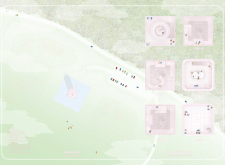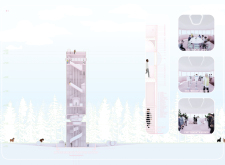5 key facts about this project
The Kurgi Farm Tower is a new architectural landmark located in the North Vidzeme biosphere of Latvia. This design represents a playful reinterpretation of classical tower structures while blending into the natural environment. The tower serves dual functions as a recreational area for horses and a public space for visitors, emphasizing the interaction between architecture and nature.
Design Intent
The aim of the design is to combine beauty with practicality. The tower features vertical elements that enhance the visitor experience. It is organized into distinct zones connected by uniquely designed staircases. These areas guide guests through various levels of the structure, offering differing atmospheres and viewpoints. With three 360-degree viewing decks and several expressive rooms, the design invites exploration and engagement.
Water and Energy Integration
A significant aspect of the Kurgi Farm Tower is its approach to water management. The design incorporates a system that allows for water retention, serving as both an energy sink and a recreational space for horses. Water balls are used to enhance sustainability by integrating heat pumps and semi-transparent photovoltaics. This system not only promotes energy efficiency but also creates an enjoyable environment within the building.
Material and Ecological Context
Sustainability plays a key role in the choices made for the tower's materials. The building uses materials that are ethically sourced and certified by the Forest Stewardship Council. These materials are reclaimable and upcyclable, indicating a focus on ecological responsibility. Native plants are integrated around the tower to provide natural screening for the horses, improving the visitor experience as they approach.
Aesthetic and Spatial Experience
The design emphasizes a strong connection between visitors and the surrounding environment. As they move through the tower, guests find various viewpoints of both the landscape and the horses. Vertical elements create interesting sightlines, adding depth to the experience. Each interaction encourages visitors to engage more fully with both the architecture and nature, fostering a sense of curiosity and exploration.






















































